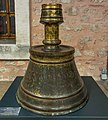Turkish and Islamic Arts Museum
Türk ve İslam Eserleri Müzesi | |
 | |
 | |
Former name | Museum of Islamic Endowments |
|---|---|
| Established | 1914 |
| Location | Istanbul, Turkey |
| Coordinates | 41°0′22.68″N 28°58′28.42″E / 41.0063000°N 28.9745611°E |
| Type | Museum |

The Turkish and Islamic Arts Museum (Turkish: Türk ve İslam Eserleri Müzesi) is a museum located in Sultanahmet Square in Fatih district of Istanbul, Turkey. Constructed in 1524, the building was formerly the palace of Pargalı Ibrahim Pasha, who was the second grand vizier to Suleiman the Magnificent, and was once thought to have been the husband of the Sultan's sister, Hatice Sultan.
The collection includes notable examples of
groups. These displays recreate rooms or dwellings from different time periods and regions.The space utilized for the museum was once a ceremony hall for the original Palace.
History
In 1914 it originally opened as the Museum of Islamic Endowments housed in the Süleymaniye Complex.
Exhibitions
In January 2015 the museum closed due to renovation needs and re-opened in April 2015 debuting the new exhibitions. groups. These displays recreate rooms or dwellings from different time periods and regions.
Current
Today the museum contains some of the finest carpets from the
See also
- Sultanahmet
- Istanbul Archaeology Museum
- İstanbul Modern
- Topkapı Palace
Collection highlights [16]
-
Pilgrimage proxy scroll, dated 1206. Ayyubid dynasty
-
Figurative architectural fragment, 13th century. Artuqid dynasty
-
Plaster relief, 13th-14th century. Sultanate of Rum
-
Rug from the Alâeddin Mosque, 13th century
-
Al-Nasir Muhammad Qur'an. Cairo, 1313–1314
-
Miletus ware, 15th century
-
Mihrab candlestick made for sultan Bayezid II, c. 1488
-
Qur'an manuscript copied by Şeyh Hamdullah, dated April 1494
-
Holbein carpet, Bergama region, 16th century
-
Calligraphic album ('muraqqa') of Ahmed Karahisari. Istanbul, c. 1550
-
Endowment Charter ('Waqfiyya') ofHürrem Sultan. Istanbul, 1556–1557
-
Tile Panel with a Picture of the Kaaba
-
Manuscript ofZubdat al-Tawarikh. Istanbul, 1583
-
Aigrette holder. Istanbul, 16th century
-
Manuscript of Siyer-i Nebi. Istanbul, 17th century
-
Ottoman qiblanuma, portable astronomical instrument showing the direction to the Ka'ba. Istanbul, 1738
-
Ewer and basin set. Istanbul, 1870
References
- ArchNet: Islamic Architecture Community - Ibrahim Pasha Palace
- ^ "İstanbul - Turkish and Islamic Arts Museum". www.ktb.gov.tr. Retrieved 2020-11-08.
- ^ "Müze Kart resmi sayfası". T.C. Kültür ve Turizm Bakanlığı (in Turkish). Retrieved 2020-11-08.
- ^ "Müze Kart resmi sayfası". T.C. Kültür ve Turizm Bakanlığı (in Turkish). Retrieved 2020-12-05.
- ^ "Museum of Turkish & Islamic Art, Istanbul, Turkey". Turkey Travel Planner. Retrieved 2020-11-06.
- ^ "Discover Islamic Art - Virtual Museum". islamicart.museumwnf.org. Retrieved 2020-11-08.
- ^ "İstanbul - Turkish and Islamic Arts Museum". www.ktb.gov.tr. Retrieved 2020-11-08.
- ^ "The Art of the Qur'an: The Museum of Turkish and Islamic Arts". Freer Gallery of Art & Arthur M. Sackler Gallery. Retrieved 2020-12-05.
- ^ Shaw, Wendy (2000). Islamic Arts in the Ottoman Imperial Museum, 1889-1923. Freer Gallery of Art, The Smithsonian Institution and Department of the History of Art, University of Michigan. pp. 55–68.
- ^ "İstanbul - Turkish and Islamic Arts Museum". www.ktb.gov.tr. Retrieved 2020-11-08.
- ^ "Türk ve İslam Eserleri Müzesi". T.C. Kültür ve Turizm Bakanlığı (in Turkish). Retrieved 2020-12-05.
- ^ "İstanbul - Turkish and Islamic Arts Museum". www.ktb.gov.tr. Retrieved 2020-11-08.
- ^ "Museum of Turkish & Islamic Art, Istanbul, Turkey". Turkey Travel Planner. Retrieved 2020-11-06.
- ^ "Discover Islamic Art - Virtual Museum". islamicart.museumwnf.org. Retrieved 2020-11-06.
- ^ "The Art of the Qur'an: The Museum of Turkish and Islamic Arts". Freer Gallery of Art & Arthur M. Sackler Gallery. Retrieved 2020-12-05.
- ^ Komaroff, Linda (2000). Exhibiting the Middle East: Collections and Perceptions of Islamic Art. Freer Gallery of Art, The Smithsonian Institution and Department of the History of Art, University of Michigan. pp. 1–8.
- ^ These are objects from museum that were put at the site of Discover Islamic Art "Museum of Turkish and Islamic Arts". Discover Islamic Art. (at least those, which have image in Wikimedia commons).



















